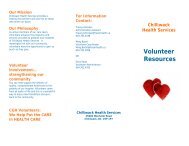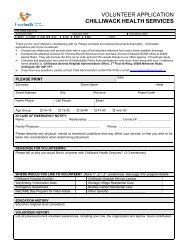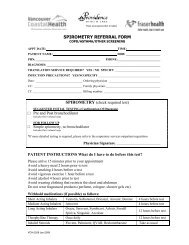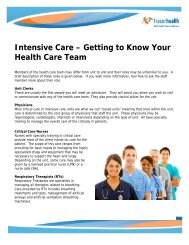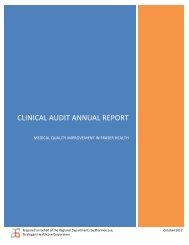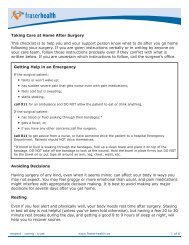Oral histories of migrant Filipino nurses in Canada - Fraser Health ...
Oral histories of migrant Filipino nurses in Canada - Fraser Health ...
Oral histories of migrant Filipino nurses in Canada - Fraser Health ...
- No tags were found...
You also want an ePaper? Increase the reach of your titles
YUMPU automatically turns print PDFs into web optimized ePapers that Google loves.
Charlene RonquilloFaculty Advisor: Dr. Geertje Boschma
Backgroundo<strong>Filip<strong>in</strong>o</strong> im<strong>migrant</strong> <strong>nurses</strong> <strong>in</strong> <strong>Canada</strong> Literature and guid<strong>in</strong>g frameworks Demographics Interview themesooPre-migrationTransition period Conclusions
Little Canadian data available Majority arrived from 1970sonwards Philipp<strong>in</strong>es as the lead<strong>in</strong>g RN donorcountry <strong>in</strong>ternationally The first steps toward exam<strong>in</strong><strong>in</strong>g thishistory <strong>in</strong> <strong>Canada</strong>
Two major perspectives:1. Economic2. <strong>Health</strong> policyChoy’s s work <strong>in</strong> the US as lead<strong>in</strong>g authority onthis topic‣ Relationship between US and Philipp<strong>in</strong>es,‘culture <strong>of</strong> migration’, , reconceptualization <strong>of</strong>temporal orig<strong>in</strong>s‣Go<strong>in</strong>g beyond dom<strong>in</strong>ant economicperspective‣ Life stories important <strong>in</strong> understand<strong>in</strong>gexperiences
1. What do the oral <strong>histories</strong> tell us about the contextand larger <strong>in</strong>fluences at play <strong>in</strong> the decision toemigrate?2. How were the motivations to migrate and transitionexperience to life and work <strong>in</strong> <strong>Canada</strong> remembered?3. What was the relationship between larger <strong>in</strong>fluencesand migration trends <strong>in</strong> the literature, and each<strong>in</strong>dividuals’ experiences <strong>of</strong> immigration?
N<strong>in</strong>e female registered <strong>nurses</strong> currently practic<strong>in</strong>g <strong>in</strong> Calgary,AB or Vancouver, BCEarly 30s to late 50s7 baccalaureate degrees, 2 hospital-based schools <strong>of</strong> nurs<strong>in</strong>gEntry to <strong>Canada</strong>› 2 through Live-In Caregiver program› 5 through sponsor (either family or recruitment agency)› 2 <strong>in</strong>dependent im<strong>migrant</strong>sArrival <strong>in</strong> <strong>Canada</strong>› 1 <strong>in</strong> early 1970s› 1 <strong>in</strong> early 1980s› 2 <strong>in</strong> 1990s› 5 from 2000 to 2007
Background - Culture <strong>of</strong> migration Philipp<strong>in</strong>es’ long historyas a “send<strong>in</strong>g nation” Establishment <strong>of</strong> Westernnurs<strong>in</strong>g education andpromotion <strong>of</strong>immigration Coupled with overseaslabour export as <strong>of</strong>ficialgovernment policy
Internalized desire tomigrateCulture <strong>of</strong> migrationR: “In the Philipp<strong>in</strong>es, the US isvery popular, and want<strong>in</strong>g togo to the US. Why do you th<strong>in</strong>kthat is, k<strong>in</strong>d <strong>of</strong>, a lot <strong>of</strong>people’s s first choice is to go tothe US? What’s s your op<strong>in</strong>ionon, why that is?”P: “Hmm...it’s, I th<strong>in</strong>k, it’s s thestatus? Or like, I don’t t know,because people there <strong>in</strong>Philipp<strong>in</strong>es...like when I was <strong>in</strong>college, all we knew is onlyAmerica. I want to go toAmerica.”(© 2007, www.alexfelipe.com)
Nurse volunteers“… you have to volunteer. You’re already practic<strong>in</strong>g as anurse, RN, you have already the patient assignment, youwork 8 hour shift regardless <strong>of</strong> day, even<strong>in</strong>g, or night shift,but you are not paid’” Fierce competition forjobs “Volunteer<strong>in</strong>g” to ga<strong>in</strong>work experience andentry po<strong>in</strong>t to<strong>in</strong>stitutions More recently: <strong>nurses</strong>pay<strong>in</strong>g hospitals
Family dynamics“Basically it was not my dream...it was a dream <strong>of</strong>my mom...”Sense <strong>of</strong> obligation› Some not given a choice – it’s s nurs<strong>in</strong>g or noth<strong>in</strong>g!› “Owed” to parents› Nurs<strong>in</strong>g - the ticket to success› Provid<strong>in</strong>g familial f<strong>in</strong>ancial supportIn retrospect, not a source <strong>of</strong> regret› Seen and done th<strong>in</strong>gs otherwise not possible› Ga<strong>in</strong>ed <strong>in</strong>dependence› Now liv<strong>in</strong>g lives that would have beenunatta<strong>in</strong>able otherwise
Four prom<strong>in</strong>ent themes <strong>in</strong> thetransition period:1)Opportunistic pursuit <strong>of</strong>migration2)Family cohesiveness3)Tra<strong>in</strong><strong>in</strong>g vs. expectations4)Prov<strong>in</strong>g self and perceptions<strong>of</strong> racism
Pursu<strong>in</strong>g opportunities – Get <strong>in</strong> where you can“In March we graduated. After that, we went to Manila <strong>in</strong> May to takethe board exam. And June I th<strong>in</strong>k, we left. It was too fast!”Dest<strong>in</strong>ations unimportant <strong>in</strong>itially butdesire for “settled” migrationeventuallyInformation about opportunities fromfellow <strong>nurses</strong>, relatives, social networks,and recruitment agenciesDifferent immigration experiences:recruited vs. <strong>in</strong>dividual
Family cohesiveness“I work the night shift and then I will only sleep for a couple <strong>of</strong> hoursafter. I cook d<strong>in</strong>ner so when the kids come home they havesometh<strong>in</strong>g to eat. Then by one o’clock I’m at the library ”Family as loyal, cohesive unit as a central cultural value andcentral to migration decisionsSacrifice – family first, nurs<strong>in</strong>g laterJuggl<strong>in</strong>g roles and responsibilities
Nurs<strong>in</strong>g <strong>in</strong> <strong>Canada</strong> & different expectations“Back home, doctors, they’re like gods. You can’t be on a first namebasis. Here, they treat <strong>nurses</strong> with respect. They accept suggestionsand you know you could tell them what you’re th<strong>in</strong>k<strong>in</strong>g. Back homewe can’t do that. ” Less hierarchy, greater expectations – welcomechanges …but not for everyone, one saw decreasedautonomy
Prov<strong>in</strong>g self and perceptions <strong>of</strong> racism“You're work<strong>in</strong>g <strong>in</strong> a foreign country, so what do you expect? You haveto live to their expectations. You have to prove yourself all the time,because you're not "a graduate here" or someth<strong>in</strong>g like that. ” Mixed perceptions <strong>of</strong> racism – echoes from the past Feel<strong>in</strong>g judged and prov<strong>in</strong>g self, but it’s not racism Workplaces as important source <strong>of</strong> support
Importance <strong>of</strong> oral <strong>histories</strong>Memories <strong>in</strong> the voices <strong>of</strong> the <strong>nurses</strong> themselvesPre-migration› Culture <strong>of</strong> migration› Volunteer nurs<strong>in</strong>g› Cultural pressures and constructsPost-migration› Chas<strong>in</strong>g opportunities› Family cohesiveness› Expectations <strong>of</strong> nurs<strong>in</strong>g <strong>in</strong> <strong>Canada</strong>› Prov<strong>in</strong>g self and racismExperiences l<strong>in</strong>ked to deep historical roots
Choy, C. (2010). Nurses across borders: foreground<strong>in</strong>g <strong>in</strong>ternational migration<strong>in</strong> nurs<strong>in</strong>g history. Nurs<strong>in</strong>g History Review 18(2010). Hannah Keynote lecture(delivered June 5, 2008 as part <strong>of</strong> the CAHN/ACHN International Nurs<strong>in</strong>gHistory conference)K<strong>in</strong>gma, M. (2006). Nurses on the Move: Migration and the global health careeconomy. Ithaca, NY: Cornell University PressImage from Reuters, UK. http://www.dailymail.co.uk/news/worldnews/article-1085807/Pictured-Maternity-unit-Philipp<strong>in</strong>es-style-Church-takes-governmentcontraception.html




